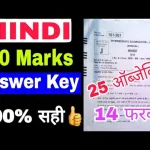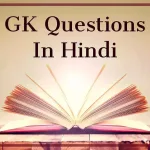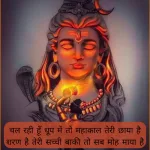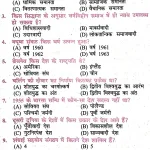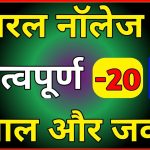Hindi (हिन्दी)
प्रश्न: ‘जयशंकर प्रसाद’ किस प्रकार के कवि माने जाते हैं?
उत्तर: जयशंकर प्रसाद छायावादी युग के प्रमुख कवि माने जाते हैं। उनकी कविताओं में कल्पना, भावनाएँ और सौंदर्य का सुंदर मेल होता है।
प्रश्न: ‘कामायनी’ काव्य का मुख्य विषय क्या है?
उत्तर: कामायनी का मुख्य विषय मानव मन की भावनाओं का विकास और संघर्ष है।
प्रश्न: ‘पथ का पथिक’ कविता में कवि क्या संदेश देना चाहता है?
उत्तर: इस कविता में कवि जीवन के संघर्षों से हार न मानने और आगे बढ़ते रहने का संदेश देता है।
प्रश्न: ‘साखी’ किस प्रकार की रचना है?
उत्तर: साखी दो पंक्तियों की छोटी कविताएँ होती हैं, जिनमें गहरी बातें सरल शब्दों में कही जाती हैं।
प्रश्न: कबीर के दोहे समाज को क्या सिखाते हैं?
उत्तर: कबीर के दोहे समाज में भक्ति, समानता और सच्चाई का मार्ग दिखाते हैं।
प्रश्न: तुलसीदास की भाषा की विशेषता बताइए।
उत्तर: तुलसीदास की भाषा सरल, भक्तिपूर्ण और भावनात्मक होती है। उन्होंने अवधी और ब्रजभाषा का प्रयोग किया है।
प्रश्न: सूरदास की कविताओं का प्रमुख विषय क्या है?
उत्तर: सूरदास की कविताओं में भगवान कृष्ण की बाल लीलाओं का सुंदर चित्रण होता है।
प्रश्न: ‘मेरे संग की औरतें’ पाठ में लेखिका ने क्या अनुभव साझा किया है?
उत्तर: लेखिका ने अपने जीवन में आई प्रेरणादायक और संघर्षशील औरतों के अनुभव साझा किए हैं।
प्रश्न: ‘भारत माता’ कविता में कवि का भाव क्या है?
उत्तर: कवि ने भारत माता को देवी के रूप में देखा है और मातृभूमि के प्रति गहरी श्रद्धा व्यक्त की है।
प्रश्न: प्रेमचंद की कहानियों में किस प्रकार की सामाजिक बातें होती हैं?
उत्तर: प्रेमचंद की कहानियाँ समाज की सच्चाई, गरीबी, अन्याय और समानता की बात करती हैं।
प्रश्न: ‘सिंधु घाटी की सभ्यता’ पाठ में क्या जानकारी दी गई है?
उत्तर: इसमें सिंधु घाटी के शहरों, उनके निर्माण, रहन-सहन और व्यापार के बारे में बताया गया है।
प्रश्न: कविता में ‘नीर भरी दुख की बदली’ का अर्थ बताइए।
उत्तर: इसका अर्थ है कि दुःख से भरे हुए भावों को आँसू रूपी बादल के रूप में दिखाया गया है।
प्रश्न: ‘भ्रमर गीत’ किस रचना का अंश है?
उत्तर: ‘भ्रमर गीत’ सूरदास की रचना ‘सूरसागर’ का अंश है।
प्रश्न: ‘नीलकंठ’ कहानी में लेखक को कौन सा पक्षी बहुत पसंद आता है?
उत्तर: लेखक को नीलकंठ पक्षी बहुत पसंद आता है क्योंकि वह सुंदर और स्वतंत्र होता है।
प्रश्न: ‘कबीर’ के दोहों में समाज सुधार का क्या स्वरूप है?
उत्तर: कबीर ने अंधविश्वास, जात-पात और बाहरी आडंबरों का विरोध किया और सच्ची भक्ति पर बल दिया।
प्रश्न: ‘हरिहर काका’ कहानी का मुख्य विषय क्या है?
उत्तर: यह कहानी बुजुर्गों के प्रति बदलते पारिवारिक रिश्तों और स्वार्थ को उजागर करती है।
प्रश्न: सूरदास की रचनाओं की भाषा शैली कैसी है?
उत्तर: सूरदास की भाषा ब्रजभाषा है, जो भावों को सुंदरता से प्रकट करती है।
प्रश्न: ‘बच्चे काम पर जा रहे हैं’ कविता में कवि ने क्या पीड़ा व्यक्त की है?
उत्तर: कवि ने बच्चों के बचपन के खो जाने और मजबूरी में काम पर जाने की पीड़ा दिखाई है।
प्रश्न: ‘विद्यापति’ किस भाषा के कवि थे?
उत्तर: विद्यापति मैथिली भाषा के प्रसिद्ध कवि थे।
प्रश्न: ‘गाँधी’ नामक पाठ में महात्मा गांधी के किस पहलू को दिखाया गया है?
उत्तर: इस पाठ में गांधीजी की सादगी, सेवा भावना और सच्चाई की शक्ति को दिखाया गया है।
Science (विज्ञान)
प्रश्न: पौधे अपना भोजन कैसे बनाते हैं?
उत्तर: पौधे प्रकाश, जल, और हवा से अपना भोजन बनाते हैं। इस प्रक्रिया को प्रकाश संश्लेषण कहते हैं।
प्रश्न: मनुष्य के पाचन तंत्र का मुख्य कार्य क्या है?
उत्तर: यह खाए गए भोजन को छोटे-छोटे भागों में तोड़कर शरीर को पोषक तत्व प्रदान करता है।
प्रश्न: जल को शुद्ध करने का एक सरल तरीका बताइए।
उत्तर: जल को उबालने से उसमें मौजूद कीटाणु मर जाते हैं और यह पीने योग्य हो जाता है।
प्रश्न: हृदय का मुख्य कार्य क्या है?
उत्तर: हृदय शरीर में खून को पंप करता है ताकि ऑक्सीजन और पोषक तत्व पूरे शरीर में पहुँच सकें।
प्रश्न: रोधी (antibiotics) का उपयोग क्यों किया जाता है?
उत्तर: रोधी दवाएँ बैक्टीरिया से होने वाले संक्रमण को रोकती हैं और शरीर को ठीक करती हैं।
प्रश्न: बिजली का बल्ब कैसे जलता है?
उत्तर: बिजली के तारों में करंट प्रवाहित होता है जो बल्ब के अंदर पतले तार को गर्म करता है और रोशनी पैदा होती है।
प्रश्न: प्रदूषण से हमें क्या हानि होती है?
उत्तर: प्रदूषण से हवा, पानी और मिट्टी खराब होती है और यह हमारे स्वास्थ्य के लिए हानिकारक होता है।
प्रश्न: मनुष्य की हड्डियाँ किसलिए ज़रूरी हैं?
उत्तर: हड्डियाँ शरीर को आकार देती हैं, अंगों की रक्षा करती हैं और हमें खड़ा रहने में मदद करती हैं।
प्रश्न: वायु में कौन-कौन से गैसें होती हैं?
उत्तर: वायु में मुख्यतः नाइट्रोजन, ऑक्सीजन, कार्बन डाइऑक्साइड और अन्य गैसें होती हैं।
प्रश्न: साबुन कैसे काम करता है?
उत्तर: साबुन तेल और गंदगी को पानी में घुलने लायक बनाता है जिससे वह धोकर हट जाती है।
प्रश्न: हरे पौधे रात में ऑक्सीजन क्यों नहीं बनाते?
उत्तर: क्योंकि रात में सूर्य का प्रकाश नहीं होता जिससे प्रकाश संश्लेषण नहीं हो पाता।
प्रश्न: चुम्बक किसे आकर्षित करता है?
उत्तर: चुम्बक लोहे जैसी चीज़ों को अपनी ओर खींचता है।
प्रश्न: इंसानों को नींद क्यों आती है?
उत्तर: नींद शरीर और मस्तिष्क को आराम देने के लिए ज़रूरी होती है ताकि अगला दिन ऊर्जा से भरपूर हो।
प्रश्न: ध्वनि कैसे फैलती है?
उत्तर: ध्वनि कंपन के माध्यम से हवा, जल या ठोस में फैलती है।
प्रश्न: दूध से दही कैसे बनती है?
उत्तर: दूध में खट्टी चीज़ मिलाकर रखने से उसमें बैक्टीरिया सक्रिय हो जाते हैं और दही बनती है।
प्रश्न: भोजन सड़ने पर बदबू क्यों आती है?
उत्तर: क्योंकि उसमें बैक्टीरिया और फफूंदी पनपने लगती है जो सड़न पैदा करते हैं।
प्रश्न: वर्षा कैसे होती है?
उत्तर: सूर्य की गर्मी से पानी भाप बनता है, बादल बनते हैं और ठंडक मिलने पर पानी बरसता है।
प्रश्न: सूर्य से हमें क्या ऊर्जा मिलती है?
उत्तर: सूर्य से हमें प्रकाश और गर्मी मिलती है जो जीवन के लिए आवश्यक है।
प्रश्न: जल ही जीवन क्यों है?
उत्तर: क्योंकि जल पीने, खाना पकाने, नहाने और फसलों के लिए ज़रूरी होता है।
प्रश्न: पेड़-पौधों का हमारे जीवन में क्या महत्व है?
उत्तर: वे ऑक्सीजन देते हैं, छाया देते हैं और वातावरण को स्वच्छ बनाते हैं।
Social Science (सामाजिक विज्ञान)
प्रश्न: भारतीय संविधान कब लागू हुआ?
उत्तर: भारतीय संविधान 26 जनवरी 1950 को लागू हुआ।
प्रश्न: भारत का पहला प्रधानमंत्री कौन था?
उत्तर: पंडित जवाहरलाल नेहरू भारत के पहले प्रधानमंत्री थे।
प्रश्न: लोकतंत्र का क्या मतलब है?
उत्तर: लोकतंत्र वह व्यवस्था है जहाँ जनता अपने प्रतिनिधियों को चुनती है।
प्रश्न: गांधीजी ने किस आंदोलन की शुरुआत की थी?
उत्तर: गांधीजी ने ‘असहयोग आंदोलन’, ‘नमक सत्याग्रह’ और ‘भारत छोड़ो आंदोलन’ की शुरुआत की थी।
प्रश्न: जलवायु और मौसम में क्या अंतर है?
उत्तर: मौसम रोज़ बदलता है, जबकि जलवायु एक जगह का लंबे समय का औसत मौसम होता है।
प्रश्न: चुनाव आयोग का कार्य क्या है?
उत्तर: चुनाव आयोग स्वतंत्र और निष्पक्ष चुनाव करवाने का कार्य करता है।
प्रश्न: किसी भी देश में कानून क्यों ज़रूरी होते हैं?
उत्तर: कानून समाज में अनुशासन बनाए रखते हैं और सबको समान अधिकार देते हैं।
प्रश्न: पहाड़ और मैदान में क्या अंतर है?
उत्तर: पहाड़ ऊँचे और खड़े होते हैं, जबकि मैदान समतल और खेती योग्य होते हैं।
प्रश्न: भारत में कितने राज्य और केंद्र शासित प्रदेश हैं?
उत्तर: वर्तमान में भारत में 28 राज्य और 8 केंद्र शासित प्रदेश हैं।
प्रश्न: काशी और मदुरै किसके लिए प्रसिद्ध हैं?
उत्तर: काशी धार्मिक स्थल और मदुरै मंदिरों के लिए प्रसिद्ध हैं।
प्रश्न: भारतीय राष्ट्रीय कांग्रेस की स्थापना कब हुई?
उत्तर: 1885 में भारतीय राष्ट्रीय कांग्रेस की स्थापना हुई।
प्रश्न: नागरिक के मूल अधिकार क्या होते हैं?
उत्तर: जैसे – समानता का अधिकार, स्वतंत्रता का अधिकार, शिक्षा का अधिकार आदि।
प्रश्न: हरित क्रांति क्या है?
उत्तर: हरित क्रांति वह समय था जब भारत में कृषि उत्पादन बहुत बढ़ गया।
प्रश्न: किसी गाँव की अर्थव्यवस्था में किसान का क्या योगदान होता है?
उत्तर: किसान अनाज उगाते हैं जो गाँव और देश दोनों का पेट भरता है।
प्रश्न: ग्राम पंचायत क्या होती है?
उत्तर: ग्राम पंचायत गाँव की सबसे छोटी शासन इकाई होती है, जो विकास और साफ-सफाई जैसे कार्य करती है।
प्रश्न: राजा राममोहन राय कौन थे?
उत्तर: वे समाज सुधारक थे जिन्होंने सती प्रथा के खिलाफ आवाज़ उठाई।
प्रश्न: कारखानों के बढ़ने से क्या समस्या हुई?
उत्तर: इससे प्रदूषण बढ़ा, शहरों की भीड़ बढ़ी और पर्यावरण को नुकसान पहुँचा।
प्रश्न: भारतीय राष्ट्रीय ध्वज में कितने रंग होते हैं?
उत्तर: इसमें तीन रंग होते हैं – केसरी, सफेद और हरा।
प्रश्न: हमारे देश का राजधानी शहर कौन सा है?
उत्तर: नई दिल्ली भारत की राजधानी है।
प्रश्न: ताजमहल कहाँ स्थित है?
उत्तर: ताजमहल आगरा में स्थित है|
Recommended Indian Reference Books for UP Board 10th Question Paper 2018 Preparation
-
High School Hindi – Vyakaran Aur Rachna
Author: Dr. Vasudev Nandan Singh
Publisher: Madhuban Publications
Content Type: Grammar rules, letter and essay writing, unseen passages, and practice exercises tailored to the UP Board syllabus. -
UP Board Science Class 10 Guide
Author: S.K. Singh
Publisher: Vidya Prakashan Mandir
Content Type: Chapter-wise theory in simple language, topic-based questions, very short to long answers, and practical-based questions. -
Samajik Vigyan – Class 10
Author: Renu Sinha
Publisher: Arihant Publications
Content Type: History, Civics, Geography, and Economics with maps, NCERT-based questions, HOTS (Higher Order Thinking Skills), and model papers. -
UP Board English Grammar and Composition – Class 10
Author: H. Martin & Sanjay Sinha
Publisher: Goyal Brothers Prakashan
Content Type: English grammar rules, translation, writing skills, comprehension passages, and previous year’s exam-style questions. -
Ganit Sankalan – Class 10 (Mathematics)
Author: M.L. Aggarwal
Publisher: Avichal Publishing Company
Content Type: Conceptual clarity with examples, practice sets, word problems, and past UP Board questions with easy explanations. -
Science Guide for Class 10 (UP Board)
Author: Lakhmir Singh & Manjit Kaur
Publisher: Bharti Bhawan
Content Type: Biology, Chemistry, and Physics concepts in easy terms, real-life examples, and chapter-end questions with detailed solutions. -
Nirmal Hindi Class 10
Author: Dr. Kamlesh Sharma
Publisher: Nirmal Publications
Content Type: Literature summaries, important questions from poems and prose, and value-based questions for board preparation. -
Sanskrit Darpan – Class 10
Author: Dr. Shyam Sundar Shastri
Publisher: Krishna Prakashan Mandir
Content Type: Shlokas with meanings, grammar portions, translations, and chapter-wise exercises according to UP Board patterns. -
Social Science Score Booster – Class 10
Author: Pooja Rastogi
Publisher: Target Publications
Content Type: Answer writing format, maps practice, topic summaries, expected questions, and board-suitable model papers. -
Navneet Hindi Digest – Class 10
Author: Editorial Team
Publisher: Navneet Education
Content Type: Lesson-wise explanation, grammar practice, writing skills section, and solved previous year’s questions. -
Foundation Science for Class 10
Author: H.C. Verma
Publisher: Bharati Bhawan
Content Type: Concept-based approach with real-world illustrations, short and long answers, conceptual review questions. -
Master the NCERT – Science & Mathematics
Author: Sanjeev Kumar
Publisher: Arihant Publications
Content Type: NCERT line-by-line explanation, MCQs, assertion-reasoning type questions, and sample board questions. -
All-in-One Hindi A & B – Class 10
Author: Megha Agrawal
Publisher: Arihant Publications
Content Type: Chapter summaries, unseen passages, grammar, and writing sections along with self-assessment tests. -
Score More in Mathematics – Class 10
Author: R.D. Sharma
Publisher: Dhanpat Rai Publications
Content Type: Simple methods to solve problems, formulas explained in steps, application-based questions, and solved exercises. -
Geography Made Simple – Class 10
Author: Anjali Srivastava
Publisher: Saraswati House
Content Type: Chapter maps, important terms, reasoning-based geography questions, and UP Board format map work. -
Uttar Pradesh Madhyamik Vigyan – Class 10
Author: Anil Kumar
Publisher: Goyal Brothers Prakashan
Content Type: Local examples added to textbook concepts, detailed question banks, model test papers, and diagrams for quick understanding. -
History Guide for Class 10 – India and the Contemporary World
Author: Dinesh Shukla
Publisher: Vidya Publications
Content Type: Important events, timeline summaries, long answer frames, and previous year patterns. -
NCERT Exemplar Problems – Science Class 10
Author: NCERT Faculty Team
Publisher: NCERT
Content Type: Conceptual reasoning, tricky questions, objective questions, and activity-based content focused on conceptual depth. -
Topper’s Key to Success – Class 10 All Subjects
Author: Editorial Team
Publisher: Kiran Institute of Career Excellence
Content Type: Mixed subject-wise questions, topper’s tips, time management strategy, and 2018-style model sets with answer hints. -
Golden Social Science Guide – Class 10
Author: R.K. Sharma
Publisher: New Age International Publishers
Content Type: Well-structured answers, case-based questions, project help, and topic summaries with map practice.
UP Board 10th Question Paper 2018: A Valuable Resource for Exam Preparation
The UP Board 10th Question Paper 2018 continues to be a crucial resource for students preparing for their board exams. Whether you’re aiming to understand the pattern or improve your writing skills, reviewing the 2018 paper can give you a strong foundation.
The 2018 question papers followed a balanced format that tested conceptual clarity and writing precision. Each subject had a mix of objective, short-answer, and long-answer questions that were aligned with the UP Board curriculum. This makes them perfect for practice if you’re revising topic-wise or attempting full paper mock tests.
One of the most effective strategies is to solve the actual 2018 papers under timed conditions. It helps in managing exam stress and improving speed. Practicing these papers repeatedly can help students identify frequently asked questions and improve accuracy.
For example, in Hindi, grammar-based questions and letter-writing formats from 2018 often reappear with slight variations. In Science, many questions focused on understanding real-life applications of topics like electricity, life processes, and environmental issues. Social Science papers had a good balance of historical events, geographical map work, and civics-based analytical questions.
Students often overlook the importance of analyzing the marking scheme. The 2018 UP Board 10th question papers included internal choices and value-based questions that awarded marks for logical presentation, even if the exact textbook answer wasn’t provided. This gave students a chance to express understanding rather than rote learning.
According to academic experts, solving old board papers like the 2018 edition helps students familiarize themselves with answer structuring. For long answers, it’s not just what you write, but how you write it that matters. Well-labeled diagrams in Science, proper map entries in Geography, and a strong introduction in Hindi essays are all scoring elements noticed in the 2018 assessment.
Another reason the 2018 paper stands out is its relevance to current trends. Though the syllabus may evolve slightly, the type of questions asked — especially in grammar, comprehension, and mathematics word problems — remain similar. Practicing with the 2018 paper allows students to build confidence, anticipate question types, and avoid common mistakes seen in real board settings.
Students should also make use of model answers based on the 2018 paper. These model solutions help identify how to write to-the-point, examiner-friendly responses. Consistency, neatness, and clarity of thought — all evident in good 2018 answers — remain key factors in scoring well.
Teachers often recommend combining the 2018 paper with other recent years to spot patterns and strengthen weak topics. For instance, if a student finds trigonometry or civics difficult, comparing how these topics were treated in 2018 and beyond can offer insight into recurring challenges.
FAQ for up board 10th question paper 2018
Q1: Why is the UP Board 10th question paper 2018 important for students?
The 2018 paper helps students understand question formats, important topics, and the board’s evaluation pattern.
Q2: Are the questions from 2018 still relevant today?
Yes, many topics and formats remain consistent. Practicing these improves conceptual clarity and exam readiness.
Q3: Can I rely only on the 2018 paper for board exam preparation?
While helpful, it’s best to use it alongside other years’ papers, textbooks, and revision notes for comprehensive preparation.
Q4: What subjects were covered in the UP Board 2018 Class 10 paper?
All main subjects like Hindi, English, Science, Mathematics, Social Science, and Sanskrit were included.
Q5: Were there any internal choices in the 2018 paper?
Yes, several questions had internal choices, especially in long-answer sections, giving students flexibility in answering.
Q6: How can I use the 2018 question paper effectively?
Solve it under exam conditions, analyze your mistakes, and revise the concepts behind the wrong answers.
Q7: Where can I find the best way to structure answers like in the 2018 paper?
Look at model answers or consult teachers for guidance on presentation, word limit, and explanation style.
Q8: Did the 2018 paper have any unexpected questions?
While most questions followed the syllabus, a few tested application skills and critical thinking, especially in Science.
Q9: Is it helpful to practice the 2018 paper multiple times?
Absolutely. Repetition helps improve speed, confidence, and understanding of frequently asked question types.
Q10: What was the difficulty level of the 2018 question paper?
Overall, the 2018 paper was considered moderate with a fair balance between easy and challenging questions.
Latest Posts
- Step-by-step guide to download and apply for jee mains admit card 202
- Comprehensive 2025 government holidays and recruitment details for job seekers
- JEE Mains Admit Card 2025: Your Step-by-Step Guide to Downloading the Hall Ticket
- Everything You Need to Know About 2025 Government Holidays Recruitment
- Comprehensive Guide to rrb d group recruitment 2025 – Eligibility, Vacancies, and Application
- Detailed guide to nps trust recruitment 2025 vacancies, eligibility and apply process
- Comprehensive guide to hpcl recruitment 2025 notification, vacancies, and application process
- ignou bed admission 2025 complete recruitment guide with eligibility and process
- Comprehensive Guide to Indian Army Agniveer Recruitment 2025 Notification and Jobs
- Everything You Must Know About CBSE Board Exams 2025 Changes & New Rules

